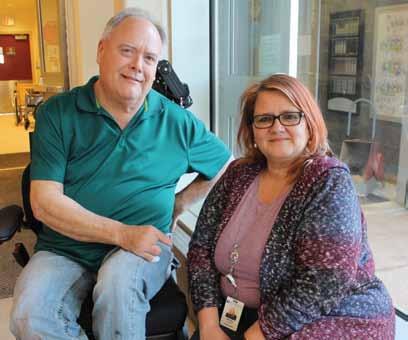
4 minute read
Top Priority
Need to prioritize transportation for dialysis patients
by Heidi Westfield
Advertisement
q Sault Ste. Marie’s Accessibility Advisory Committee (AAC) gather at a recent meeting. W hen Newfoundland was hit with a record-breaking blizzard early this year, Shirley Pulkkinen’s first thought was: “What is happening to the dialysis patients out there? How are they going to get to their treatments?”
During that emergency, officials on the East Coast made access to hospitals for hemodialysis patients a top priority as soon as it was safe to do so. Shirley finds that kind of response encouraging. As a longtime renal social worker, she has seen the difficulties kidney patients can face getting to their dialysis treatments.
“For some people their health is so fragile that missing one dialysis session may kill them,” she says. “This is a life-and-death situation. We need to have the infrastructure to ensure that dialysis is not overlooked and is part of emergency plans for every community.”
Shirley is among a growing number of advocates across Ontario bringing attention to the transportation barriers facing dialysis patients. She is a member of a group of volunteers who comprise the Accessibility Advocacy Committee (AAC) for the city of Sault Ste. Marie. They are working to highlight some of the limitations of local transit options and call for more affordable, accessible services. She would like to see:
• Short er wait times for accessible rides • Expa nded/flexible hours of transit that better coincide with dialysis appointments • Pri oritizing dialysis patients on services such as Para Bus • Mor e wheelchair-accessible taxis • Door-to-door services for those people requiring it (currently it is curb-to-curb).
She recalls how last winter Sault Ste. Marie was hit with a major snowstorm that made travel very difficult. Cars couldn’t get out of driveways, and private taxis were taken off the roads.
“I came in to work on Monday in a 4X4 truck but half of my patients couldn’t get in for dialysis, so they had a long stretch of time without dialysis as their last session was on a Friday.” With the renal team, she was able to juggle the next day’s schedule to bring in all the patients who missed earlier appointments, but it was a very stressful situation.
Shirley has found that one of the biggest misconceptions about dialysis patients is that they “appear” healthy, and able to get around on their own. “People with kidney failure may look fine on the outside,” she notes, “but they are often exhausted and vulnerable.” Many patients are elderly and have mobility issues. Others live on a very limited income. It is hard enough on a regular day to get themselves back and forth from hospital. When there is a blizzard, ice storm or flooding of the access highways, the task becomes incredibly daunting.
“People on dialysis have a hidden disease that you cannot see, touch or feel but it is there. We need to take care of these patients and get them to and from dialysis safely.”
Have you had trouble getting to hemodialysis appointments? We want to hear from you. Please contact us to share your experience of how you have been impacted.
Email: Ontario.programs@kidney.ca or call 1.800.387.4474 ext. 4970. M y name is Malcolm, and I live in Sault Ste. Marie. I have kidney disease and visit a local hospital three times a week for hemodialysis treatments. I also have mobility issues, p Malcolm and Shirley Credit: Rose Calibani

and use a wheelchair to get around.
What I would like Canadians to understand is that dialysis is an absolute must for people like me, who live with end-stage kidney disease. Every single thing you undertake and want to do, you have to think about dialysis first. My dialysis sessions in hospital keep me alive.
The problem is, getting to those treatments can be a challenge. There are special city buses for people with mobility issues, but the bus schedule does not always coincide with my medical appointments. Having more buses on the road, with extended hours, would make a big difference for people in wheelchairs who rely on public transit.
I often take a wheelchair taxi to the hospital for dialysis sessions instead. The taxis are better because they can back up into your driveway, while the buses only offer curb-to-curb service. This makes a big difference when the weather is cold and there is a lot of snow and ice. The challenge is that taxis are more expensive. A one-way trip from home to the hospital costs me about $22. The Ontario Disability Support Program (ODSP) covers the cost of taxis now, but I will lose this benefit when I turn 65.
A growing number of people in Ontario need dialysis, and many of them are not great with mobility. I would like to see more attention focused on transportation issues, especially in Canada where weather is often a barrier. Governments should be more on top of this, to ensure dialysis patients are getting where they need to go.
Don’t be afraid to voice your needs to your healthcare providers, to ODSP, and anyone else who provides your transportation.










